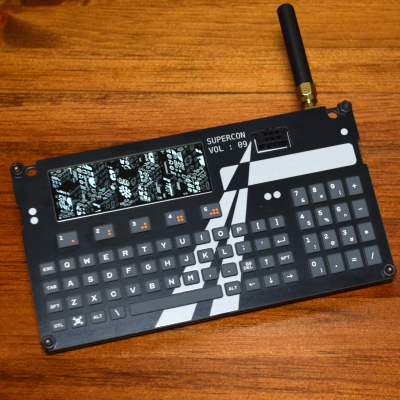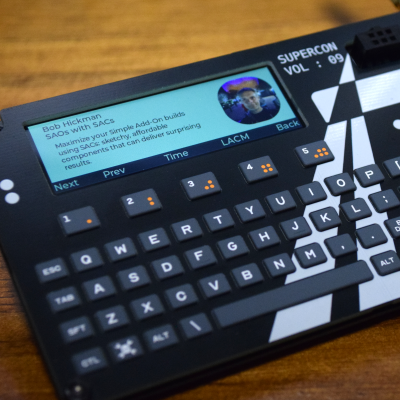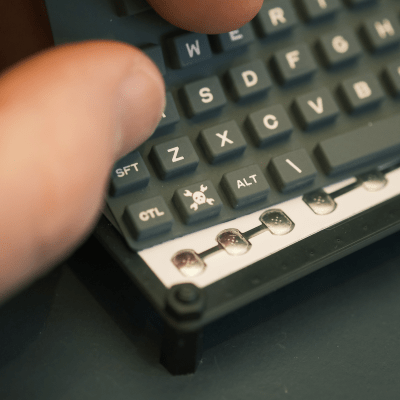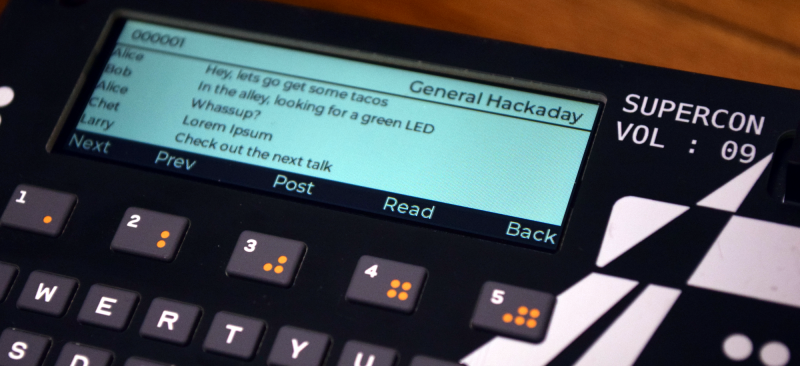It’s the moment you hard-core hardware nerds have been waiting for: the reveal of the 2025 Hackaday Supercon Communicator Badge. And this year, we’ve outdone ourselves, but that’s thanks to help from stellar collaboration with folks from the community, and help from sponsors. This badge is bigger than the sum of its parts, and we’ve planned for it to be useful for you to hack on in the afterlife. Indeed, as always, you are going to be the final collaborator, so we can’t wait to see what you’ll do with it.
 We’re going out – wide out – on a limb and trying to create a dense mesh network of badges talking to each other at Supercon. It’s going to be like a badge-hosted collection of chat rooms, as connected as we can make them without talking over each other.
We’re going out – wide out – on a limb and trying to create a dense mesh network of badges talking to each other at Supercon. It’s going to be like a badge-hosted collection of chat rooms, as connected as we can make them without talking over each other.
You look up a topic, say Retro Computing or SAO trading, punch in the channel number on the numpad, and your badge starts listening to everything going on around that topic. But they also listen to everything else, and repeat anything they hear on to their neighbors. Like IRC, but LoRa.
But let’s talk hardware. The first thing that hits you is the custom keyboard, a hat-tip to portable computing devices of yore, but actually infinitely more capable and even nicer under the thumbs. Behind the keyboard is a custom dome-switch sticker sheet and a TC8418 I2C keyboard matrix multiplexer chip, which does away with all of the diodes and decoding and makes a keyboard design easy.
In the driver’s seat is an ESP32-S3, courtesy of Espressif, no less. We asked, and they made it rain: it’s the good one with 8 MB of PSRAM and 16 MB of flash – plenty of room for about anything, and just enough pins to run the show. We needed the form-factor of the LCD screen for the aesthetics, and we’ll just say there’s not much choice in this shape; we had to go for an LCD with a strange newish driver chip, but we made it work with the help of sketchy Arduino init scripts found around the interwebs.
Did we mention LoRa? A Communicator Badge is no good without a means of communication. Seeed makes these nice little SX1262 LoRa modules, and they were our first choice not only because they’re cute, but also because they come with a bring-your-own antenna option, and they had enough of them in stock. (This is not to be underestimated these days!) SMA adapter, LiPo and charging circuitry, and badge is your uncle! Super thanks go out to DigiKey for sponsoring us all manner of needed components.
Radio Frequency Madness
Here is where we run into our first problem, and it’s the exact opposite of the problem that mesh networks are designed to solve. Those little LoRa radios transmit easily 1 km to 2 km in open space, maybe half that in an urban neighborhood. And we’re putting 500 hundred of them in the alley, with often just a couple meters between badges.

Still, we’ve got some tricks up our sleeve, we’ve got a lot of bandwidth at our discretion, and we’ve got a smart bunch of hackers. We can make this work, and we will have some odd corners of radio spectrum for you to play around with too. Get together with a couple friends and have fun with RF.
We’ll also be broadcasting Supercon-relevant news out to the badges from time to time. Things like which talks are coming up, when and where the food has arrived, and so on.
The Keyboard
 Back to the keyboard. Hackaday superfriend [Arturo182] was one of the first few people to make the new-old-stock Blackberry keyboards usable for the masses, building on the work of [JoeN] and [WooDWorkeR]. But hacker demand has dried up the global stock of the old gems, and [Arturo] turned to making his own keyboards under the Solder Party moniker. We saw his prototypes and had to get in on the action.
Back to the keyboard. Hackaday superfriend [Arturo182] was one of the first few people to make the new-old-stock Blackberry keyboards usable for the masses, building on the work of [JoeN] and [WooDWorkeR]. But hacker demand has dried up the global stock of the old gems, and [Arturo] turned to making his own keyboards under the Solder Party moniker. We saw his prototypes and had to get in on the action.
Other badges have come out using his stock keyboard, but only Hackaday and Supplyframe’s Design Lab was foolish enough to do something totally custom. Actually, it was super easy with [Arturo] leading the keyboard project, because he knows all about the details of preparing the designs for the keyboard dome sheets, and worked with the Design Lab team and Supplyframe’s designer [Bogdan Rosu] to get the custom silicone covers looking pretty. Thanks [Arturo]!
The Software?
The software is still under wraps. The folks at Design Lab are turning out badges as fast as they can, even as we write this, and that means that we’re still working on the software. The last minute is the sweetest minute. Again, though, we’re not alone.
The brains behind the software effort is [Spaceben], and I have to say I haven’t seen such clean Python code in my life. Everything is possible when you have good folks on your team.
We’re using the LVGL graphics framework for Micropython, which makes the GUI design a lot snazzier than it would otherwise be. It was also easy enough to port our funny display driver to lvgl_micropython, and we’re working on the keyboard too. We’ll see what works on Supercon Day 1!
Your Turn
And that brings us to you! Mesh-network-IRC is fun during the conference, but after the fact, these badges are going to be too good to just leave on the shelf. Porting Meshtastic to the badge would be a fantastic project. The keyboard, WiFi, and Bluetooth connectivity just beg for some kind of handheld remote-control device design. The panel for a home automation setup? Or heck, go super simple and just wire the I2C keyboard out to your next project that needs one. We’d bet a Jolly Wrencher sticker that the badge could be quickly transformed into an ELRS radio control unit.
We love the badge scene, and like many of you out there, we find it’s a pity when the badges just sit in the closet. So we tried to plan for the afterlife here by making the badge hardware as useful as we could, and by making the software side as accessible as possible. Those of you who hack on the badge during Supercon, you’ll be blazing the trails for the rest of us afterwards.
We hope you find it fun to chat with others at Supercon, a fun platform to work on, and something useful after the fact. Managing an ad-hoc chaos mesh network isn’t going to be easy, but the real goal is the friends you meet along the way. See you all at Supercon!

















Very special thanks to the amazing DesignLab engineering interns — Kris, Jocelyn, and Chris S. — and to the Hackaday community volunteers who are helping us right now put the badges together, troubleshoot, test, and more. Brandon, Dave, Will, Mike, Scoops, Chris, Rich, Voja, and many more — thank you!
Go go go! Good luck y’all. (And sorry I didn’t call you all out by name.)
Looks pretty cool!
Omg I need to go… I swear the communicator badge has nothing to do with it
apparently there’s still tickets, check the last link in the article
The description sounds like the badge is not using Meshtastic or MeshCore as radio protocol, but something custom. What is the reasoning behind it? I mean, developing your own mesh protocol and making it actually work isn’t that easy, while these projects have working code, are tried and the ugliest quirks flushed out.
So why not use one of these, with some custom UI and custom message handling to implement the IRC-like functionality?
Totally good question!
Part of it is b/c Supercon is exactly the contention/congestion situation that gives Meshtastic the most trouble. Although they seem to have done pretty well at DEFCON this year, aside from the obvious problems of running a secure network at a security conference: https://meshtastic.org/blog/that-one-time-at-defcon/. But at the time we were planning, it looked more like a liability.
Meshtastic has security/encryption. We don’t need that. Our goal is maximum sharing / community. If you want to say something secret — you have other ways.
Meshtastic is in C, we wanted everything to be maximally natively hackable in Python. We want you to write bots. We didn’t want to port it over.
Meshtastic is alread a fantastic product, but it’s self-sufficient. We wanted a toy for you all to play with.
We’re stoked if people use them that way afterwards, and we designed the hardware to be maximally compatible — down to looking at popular radio designs. The keyboard is custom, but the rest was designed to be as smooth as possible. Tom has been talking to Meshtastic devs, and they want to port the badge already. We had to beg them to not start before Supercon. :)
I’m just a noob at this mesh stuff but apparently Meshcore deals with congestion better than Meshtastic, and focuses more on text messaging than bolting on a million other features (which, granted, tend to be cool features)
Try to use Meshtastic in NYC and you’ll get why hundreds of people at a con is a bad use case.
Dang. I want one.
I’d like to attend but cannot. Wish there was a similar or DIY version doing a bulk order :D
We will be making more for Europe.
The only regret is that the keyboard is hard to replicate. It’s the up-front costs. But by the time Giovanni (design lab) had sketched it out, we had fallen in love with the graphic design.
That said, the experience was super enlightening. The key-dome stickers are very cool, and you could do maybe a TPU key layer that would knock down the fixed costs. Are there flexible resins for resin printers?
The keys have little “pins” on the underside, though, so they concentrate the force on the domes, which has a fantastic feel. You would probably want to replicate that if possible.
There are definitely some UV set resins that are ‘flexible’ but I’m not sure there are any that would really survive this scenario, its quite a torture tests with constant handling by messy humans and rather targeted deformation in use. The easier option is probably to use the resin printer to print a few mold and just use regular silicone sealent gun to fill ’em up (probably using a faster setting 2 part silicone rather than the usual bathroom stuff so the mould can be cycled rather quicker).
wouldn’t mind this popping up for sale on tindie
I have to say I haven’t seen such clean Python code in my life.. what’s wrong with good old fashioned dirty python code? Much under rated IMO.Honestly, if “clean” was the goal, why wasn’t the whole thing written in Whitespace? (https://en.wikipedia.org/wiki/Whitespace_(programming_language) for those not familiar).
Can’t get “cleaner” than a total lack of pixels 🙂
Wow …. that’s truly awesome !!
This is awesome and I wish I could attend.
Seconded!
Reminds me of the Sharp PC (and other “pocket computers” of the 1980s).
Must be popular form factor, since it is being regularly reinvented.
Wow both keyboard and display look amazing! This is product quality, not a badge :o
Display is not mentioned on the schematic, but there is datasheet in https://github.com/Hack-a-Day/2025-Communicator_Badge/blob/main/documentation/datasheets/ER-TFT2.79-1_Datasheet.pdf ~$4 IPS 168x428x18-bit 2.79 inch (NV3007 controller) and its gorgeous.
interesting schematic for the front panel
It’s everything I want in a little pocket computer. The keyboard alone is something I’ve been looking for off and on for years. I hope you all have fun at the meetup. I also hope you guys sell that keyboard and or the whole kit (maybe with a form factor that allows for different microcontrollers). Seriously though… I want exactly that with a few other hackable spots.
Wow! This looks rad. Can’t wait
please one with normal mechanic keyboard and 40% size planck layout
Maybe we should have put something on there for scale…
But hey, if you change a couple lines of code, you could use an external keyboard over the SAO port?
This is super slick!! I like it!!
I have spent the past 18 months of my life making something very similar :)
https://hackaday.io/project/197467-cl-32
I can’t believe you cloned the supercon badge already! Shocked! Shocked I tells ya! And appalled. Shocked and appalled at the same time!
/s 😉
Excellent! Thank you for sharing, I may consider repeating the feat.
I looked at your project, and I think that TPU, or whatever it is, sleeve that holds the board is a great idea. I don’t really like the look of the coarse finish though. But I think it gives you a good grip on the device, and that’s nice.
But to be honest, I love the Superconference badge’s keyboard. :)
But why two shift and alt keys? Why not one of each?
And the [ and ] can be in a different place too, so you can have DEL and BS in those places. The [ and ] can then go to be an ALT stat of the 9 and 0 on the numeric part.
Then the BS/DEL key can become the ?/ key, which are both always useful. The right SFT can become |. The right ALT ~
. The \ key can become left ALT, the left ALT can become the hackaday logo, the hackaday logo can become CTL, and CTL can become SFT. Then SFT could become TAB. And TAB could become ~, so that we have those on the keyboard as well.:)
Two shifts? Because if you’re thumb-typing, it’s much easier to type both capital “I” and capital “A”. You can do with a shift-lock, but meh.
Two alts was b/c some foreign language keyboards distinguish between them, and “why not”? :)
In the end, our firmware doesn’t even use ctrl or either of the alts, but we wanted to make it more flexible for other uses, whatever they’re gonna be. (Do we use tab?)
Hackaday logo key is non-negotiable.
Oh my god, that’s awesome. I really like that D-pad and the use of the Nokia battery. And e-ink! And plug-in modules!
That DIY dome-keyboard-sticker technique is great. That’s probably the way to go for anyone looking to do keyboards as a one-off, or a small run. Much more down-scalable, which ours unfortunately isn’t.
I was gonna list out all the other recent projects with a) keyboards b) LoRa radio modules or c) retro-stylings, but the list is crazy long. Especially if you only insist on two of the three…
By 2033 the Supercon badge sports a full-res phone display, powered by the latest nVidia 75W “Catmull” chip. Attendees create cool AI applications driven by the multiple cameras. A backpack is advised for the battery pod, it’s a little large for your pocket. Heavy sweatshirt recommended to prevent heat-sink burns.
Would this be a good candidate for a text adventure game like Zork or HHGTTG, Or perhaps MUD? Server controlled for state machines and to keep everyone in sync? On a mesh, timing would be a significant factor if not turn based.
Audience questions for the Q/A in talks?
The audience questions idea is a good one!
Fantastic badge! Can you share the production costs to make such a cool piece of hw?
Every time I see a conference badge on here, I get sad that I live all the way down here in Australia. Every time I see a conference badge on here, I say “please make these available for sale and I will probably buy one.”
This time I want to SHOUT it. Please take some of my money in exchange for one of these badges. Hardware keyboards rock. Mesh networks rock. That little LCD looks like it also rocks.
The Supercon 6 badge did find its way onto Tindie. Dunno about the others.
https://www.tindie.com/products/0xc0decafe/supercon-2022-badge-voja4/
https://www.tindie.com/products/0xc0decafe/supercon-2022-badge-voja4/
Thanks for sharing. Out of stock at present (who knows if they’ll do another production run) but I have signed up just in case.
All of our badges are open source hardware, and should anyone feel so inclined (like the person who created the clones of the Voja4 badge that J. Peterson links to), they are free to make their own clones to give away or sell.
But officially, we only produce enough badges for our events and then move on to next year’s design.
I don’t know if anyone will try to clone this year’s badge. The keyboard makes it tricky, as it’s simply not something you can get in small quantities. Potentially somebody in the community could organize a group buy.
500 hundred? :D
Would love to see details of making that keyboard matrix. I want to make my own PCB to go into a Blackberry Q5 shell, and it will need something like that. I took a look at the repo, but it didn’t seem to have much detail that I could see.
Maybe an article on making keyboards with those little dome switches? :-)
Dont you mean the physical keyboard? matrix is covered pretty well in diagram (TCA8418)
I would also love to read what it takes to design and order custom dome sheet.
Both, to be honest.